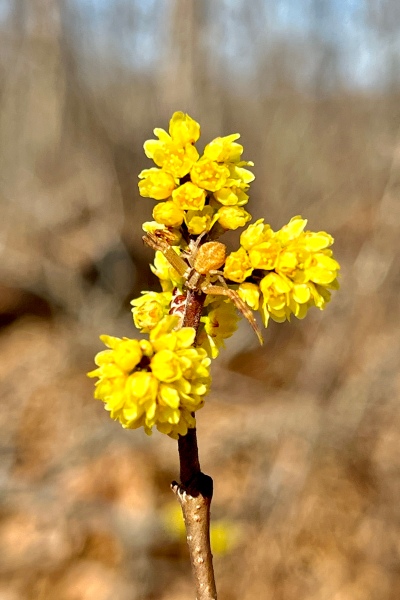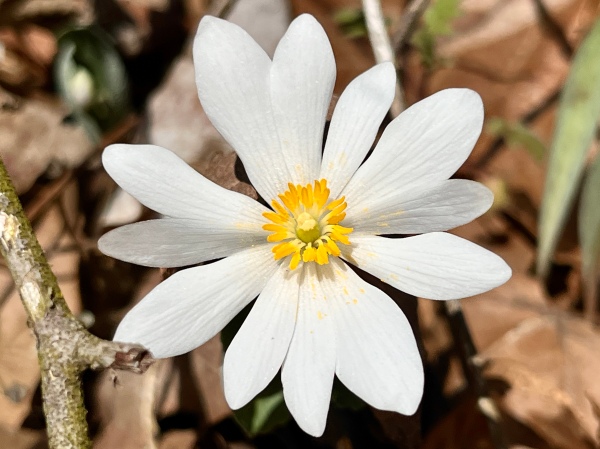Today the WGNSS Botany Group visited Little Lost Creek Conservation Area to see Dirca palustris (eastern leatherwood) in bloom. Leatherwood is a distinctive, slow-growing shrub that occurs sporadically in primarily the Ozark and Ozark Border region of Missouri. Like the much more Lindera benzoin (common spicebush), the flowers open in spring before the foliage appears, during which time the planta are easily identified by the pendulous blooms surrounded by wooly bracts. The species has toxic properties and was used by First Americans as an emetic, and it has been cultivated for many years despite its sporadic natural occurrence. As the name implies (palustris means “growing in a swamp”), the plant grows in moist (though not necessarily swampy) habitats, and as such we would have to hike across the dry-mesic upland deciduous forest and down into the riparian forests along Little Lost Creek where the plant can be found.
With sharply warmer temperatures arriving yesterday after a rather protracted cool period, the early-flowering trees and shrubs were ready and waiting, seemingly popping open before our very eyes. A patch of Prunus americana (American plum) in a more open area along the trail caught our attention, it’s blooms just beginning to open. We based our identification on the shrubby growth habit and apparently clonal nature of the stand of plants, which distinguishes P. americana from the closely related P. mexicana (Mexican plum), which generally grows as more tree-like individual plants.

Also in the more open areas along the trail was Rhus aromatica (fragrant sumac) in full bloom. I stopped to examine one particular individual with especially dense clusters of inflorescences and noticed movement on the flowers. Closer examination revealed a crab spider (family Thomisidae) which I took to be Mecaphesa asperata (northern crab spider)—perfectly camouflaged on the bright yellow flowers and awaiting the arrival of an unsuspecting bee or other pollinator.

As the trail veered directly into the forest, I noticed several butterfly species—a Vanessa atalanta (red admiral) that paused briefly on the trail before bolting erratically into the distance, several Eurytides marcellus (zebra swallowtail), presumably males patrolling for females among stands of the still leafless Asimina triloba (pawpaw) which it utilizes as a larval host, and—most interesting for me—several Anthocharis midea (falcate orangetip) which, for the time being, frustratingly refused to perch and allow even an attempt at a photograph.
As the trail began the long descent into the valley and the forest became increasingly mesic, spring ephemerals began appearing on the forest floor in abundance. Most abundant was Claytonia virginica (spring beauty) and Cardamine concatenata (cutleaf toothwort), which have been in bloom for some time now, but finally making their appearance as well were Sanguinaria canadensis (bloodroot)—the first seen being a charming little patch nestled against a rock—a single blooming plant among the stands of Erythronium albidum (white trout lily), and several still-unblooming Trillium sp. (wakerobin).



At last we reached the valley floor, and immediately the leatherwood plants were seen in abundance and in full bloom. Leatherwood plants in bloom are not among the showiest of blooming shrubs, but the distinctiveness of their flowers, sporadic occurrence, and lack of close relatives provided ample botanical interest that resulted in me spending a fair bit of time observing and photographing them.


As I looked at the leatherhood, I encountered a an unusual cocoon-like structure at the tip of one of its branches. Closer examination revealed it to be “packed” white tiny, white, grub-like larvae, at which time I noticed the cadaver of a moth caterpillar also clinging to the branch tip. I knew then that the grubs were the mature larvae of a parasitic wasp in the family Braconidae, likely in the subfamily Microgastrinae, that had just exited their host and were spinning cocoons nearby in communal fashion. (Many people have seen one of these wasps in the form of cocoons on the backs of tomato hornworm caterpillars.) Braconid wasps are often quite host specific, but a more specific identification is difficult since the identity of the caterpillar itself or whether it was utilizing Dirca as a host plant are also unknown.

If the spring ephemerals were abundant during the descent, they were overwhelming in the valley proper. A few blooming plants of Collinsia verna (blue-eyed Mary), a winter annual were seen, their distinctive bicolored white and blue flowers a pleasant contrast to the mostly white to pinkish color of the majority of the ephemerals. Some especially large-flowered individuals of bloodroot were seen underneath a patch of blooming leatherwoods, prompting me to spend a bit more time photographing them. As I was doing so, I found it ironically humorous that I was crouched on the ground photographing what is by all measures a rather common plant while surrounded by a much less frequently encountered plant.



The hike back up out of the valley was long and deliberate, the pitch in some stretches reaching as steep as I ever encounter on trails in the state, but the slow pace allowed an opportunity to look for things missed on the way down. At one point I picked up a fallen oak branch that looked like it might have been pruned by a twig pruner (Anelaphus sp.), a type of longhorned beetle (family Cerambycidae) whose larvae feed within living branches of deciduous trees—primarily oak—and then cut the branch internally before pupation. The cut end is distinctive, and I checked the base of the branch to see if it demonstrated this distinctive cut pattern. It did not, but I explained what I was looking for to a curious member of our group. Just as I finished the explanation, I saw another oak branch laying on the trail, picked it up to examine the base, and, sure enough, it exhibited the cut. I believe the branch is that of black oak (Quercus velutina), and I kept the branch to place within a rearing box so I can see the adult when it emerges later this spring.
Along the final stretch back to the parking lot, the falcate orangetip butterflies continued to torment me with their erratic, never-ending flight. I watched a few after reaching the parking lot, hoping one would alight and give a chance to photograph it, but no such luck. At the edge of the parking lot I noticed some Taraxacum sp. (dandelion) flowers with small insects on them, which turned out to be Acmaeodera tubulus—usually the first jewel beetles (family Buprestidae) to appear in the spring and commonly found on dandelions. I crouched to take a few photographs, and as I was doing so a falcate orangetip butterfly landed on the dandelion flower right next to the one with the beetles I was photographing. I managed to get one shot of the butterfly, it’s wings not well spread out but the orange tips still easily visible, before it took flight again—a nice punctuation to end the outing with.


©️ Ted C. MacRae 2023
Thanks, Ted. You add a lot to our walks. –Burt
Thanks, Burt!
Good to see you again.
Keep up the good work.
Thanks for the welcome back. Now that the collecting season is upon us I hope to post a little more frequently.
Papilio glaucus uses a wide variety of trees and shrubs as its host plants including Ptelea trifoliata (Hop tree), Fraxinus (Ash), Liriodendron tulipifera (Tulip tree, Malus (Apple), and Prunus species (Cherry). It does not use Asimina triloba (Pawpaw). Eurytides marcellus (Zebra swallowtail) is the only butterfly that feeds on Asimina triloba. It is also flying now.
Hi Phil – they were zebra swallowtails (not sure why I wrote tiger). Anyway, the post has been corrected, and thanks for pointing out the mistake.